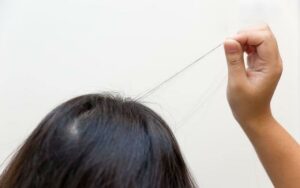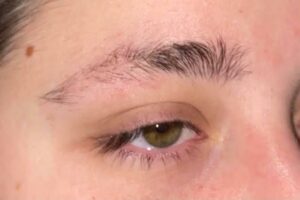Doctors say they are seeing trichotillomania, or hair-pulling disorder, cases 3-4 times a month, mostly in adolescent girls.

Representational impage of a patient with trichotillomania, where they pluck hair from parts of their body. (Wikimedia Commons)
Fifteen-year-old Tanya’s (name changed) mother wasn’t quite sure why her daughter was developing bald patches, or why hair from her eyebrows was falling off, or the reason for her eyelashes disappearing.
When Tanya refused to attend school because of her bald patches, her mother took her to a dermatologist, thinking it was some issue with her daughter’s scalp.
However, Tanya, a resident of Hubballi, was diagnosed with a psychiatric condition called trichotillomania.
People suffering from trichotillomania repeatedly pull out their hair — from their head, eyebrows, or anywhere on the body.
Without treatment, this condition, Tanya’s mother was told, can become a chronic disorder.
Surprisingly, while there is no data in India on the prevalence of such cases, psychiatrists South First spoke to confirmed they were seeing at least three to four such cases every month.
“My youngest patient was a six-year-old,” says Dr Alok Kulkarni, mental wellness expert and senior consultant psychiatrist at the Manas Institute of Mental Health and Neurosciences in Hubballi.
“There are quite a few cases that I see. My last patient was 10 days ago. There are severe cases among adolescents in the 10 to 16 age group — most of them females.”
Trichotillomania, also known as TTM, is a psychiatric condition in which the person exhibits repetitive behaviour in the form of hair-pulling, mostly affecting the hair on the head, eyebrows, eyelashes, beard, or body.
This is usually voluntary, impulsive and often occurs without the individual realising it, says Dr Narayan R Mutalik, professor and head of the department at SN Medical College Bagalkot where he sees at least three to four cases a month.
The condition generally develops during childhood or adolescence. Patients also go through severe anxiety issues, depression, and also have obsessive compulsive disorder symptoms.
While some people pull out tufts of hair, others pull out a strand at a time, says Dr Mutalik. And though families don’t understand why the person cannot stop pulling out their hair, for the person suffering from TTM it is very hard to break the habit.
“In rare cases, this habit can co-occur with what is known as trichophagia. Here the patient may be biting, chewing, licking and, in extreme cases, even swallowing their hair, causing problems in digestive tract,” Dr Mutalik says.
In June this year, a 17-year-old girl from Gaganpahad, Shamshabad, underwent a surgery in Osmania General Hosptial, Telangana, and about 2 kg of hair was removed from her intestine.
Doctors South First spoke to say a majority of the cases that come to them were referred by dermatologists.
“Most patients or their care-givers think it is a problem with hair or skin and are not aware of it as a psychiatric problem. At NIMHANS, we see at least two cases a month,” says Dr YC Janardhan Reddy, head of the, OCD Clinic and professor in the Department of Psychiatry, NIMHANS, Bengaluru told South First.
Dr Reddy explains that this condition can make people go through episodes of depression as they are unable to stop the habit even if they want to.
“I recently saw a 12-year-old girl who was referred by a dermatologist. Along with severe hair loss, leading to bald patches, the girl exhibited significant anxiety,” says Dr Mutalik.
“The dermatologist had prescribed few anti-anxiety medicines and that had not helped her. So she was referred to us. After some tests and counselling we realised she had TTM and the situation was brought under control after 12 weeks of treatment that including Cognitive Behavioural Therapies (CBT).”
People do not immediately see the condition as a psychological issue and hence dermatologists need to keep their “antennas high for detecting this condition”, Dr Mutalik adds.
Dr Kulkarni explains that patients will have other comorbidities like anxiety, mood disorders, substance misuse, eating disorders or other personality disorders.
“Comorbidity is the rule and not the exception,” he says, adding that assessment involves looking at the symptoms, diagnostic severity, functional impairment, differential diagnosis, comorbidity and global assessment of functioning.
“I use the Trichotillania Diagnostic Interview which takes around 10-15 minutes to administer,” Dr Kulkarni explains.

Hair pulling disorder can occur mostly in young adolescents. Doctors in Karnataka claim to see atleast three cases a month. (Wikimedia Commons)
While it is still not clear why some people pull out their hair, it could be due to genes, hormones which changes during puberty, stress hormones or just habit-learning which can play a role.
“When we ask patients why they pull hair, they say they get a brief sense of relief… kind of makes them feel rewarded. This becomes a habit and makes it harder for them to resist the urge to pull their hair. Low self-esteem and depression can resukt if this is not controlled,” says Dr Mutalik.
Episodes of hair-pulling may last between one hour to three hours every day, or may occur only when they are stressed about something like facing an exam or attending an interview. Tensions can also trigger this behaviour, explains Dr Mutalik.
People with impulsive discontrol associated with OCD are prone to TTM. “Management of this conditon is very tough and sometimes it gets difficult. Medications alone won’t help. Supervision, motivation, hand-holding, along with CBT, will help the client,” says Dr Mahesh Gowda of Spandana Hospitals in Bengaluru.
Dr Kulkarni says he tries non-drug approaches first. Cognitive-behavioural interventions involving habit-reversal training is the first-line of treatment, he says.
The behavioural interventions for trichotillomania have three components:

Like hair pulling from head people also indulge in eyebrow pulling causing loss of hair on eyebrows. (Wikimedia Commons)
1. Awareness training: Self-monitoring is used to improve the patient’s awareness of the urge that precedes pulling.
2. Stimulus control: A range of methods is employed that serve as “speed bumps” to reduce the likelihood that the pulling behavior starts.
3. Competing response training: Patients are taught to engage in behavior that is physically incompatible with hair-pulling till the urge subsides.
Dr Kulkarni says pharmacotherapy for trichotillomania has been disappointing. There have only been small studies examining the efficacy of certain agents. Larger, double-blind randomised controlled trials are needed to make conclusive recommendations.